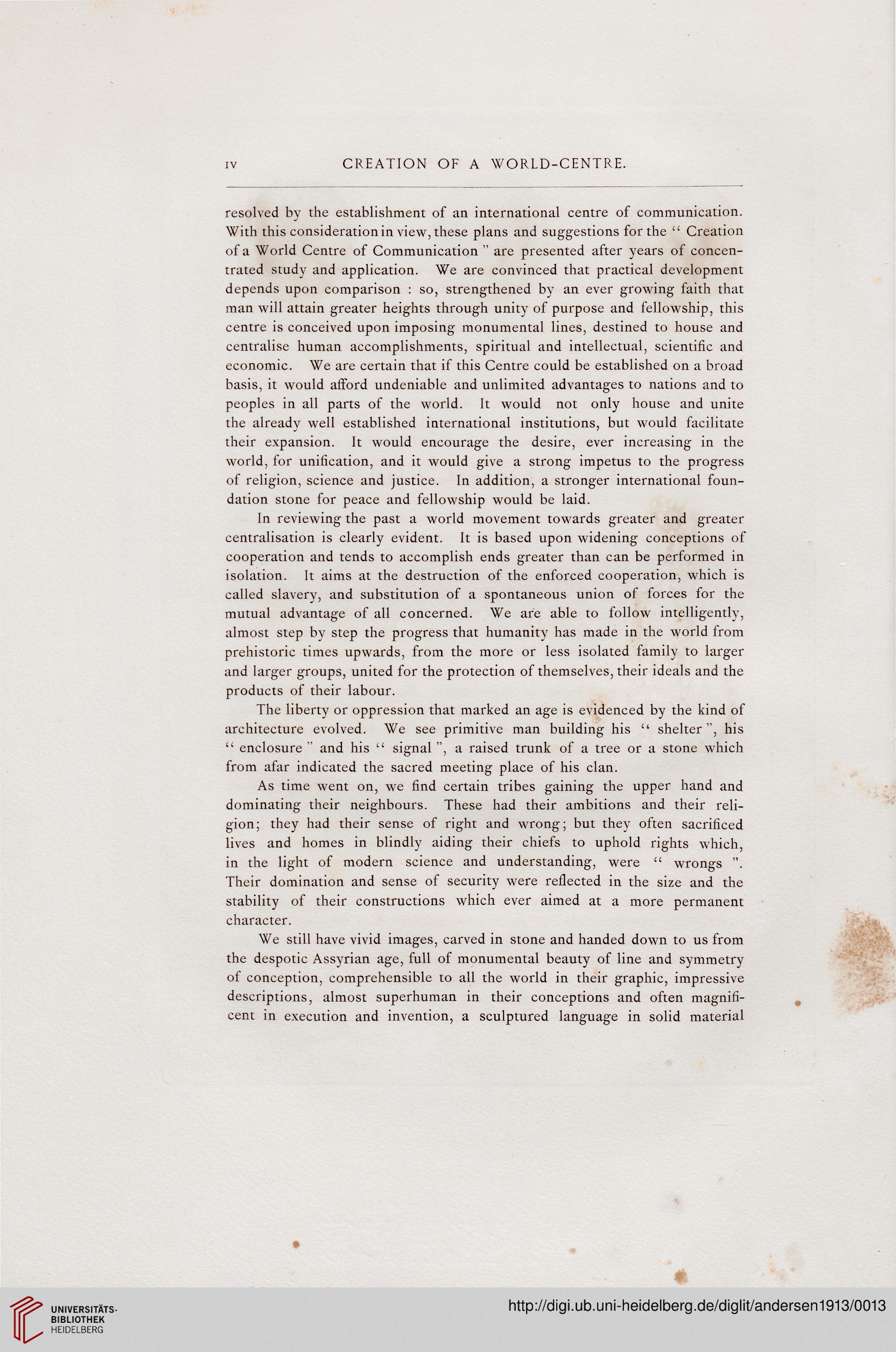IV
CREATION OF A WORLD-CENTRE.
resolved by the establishment of an international centre of communication.
With this consideration in view, these plans and suggestions for the " Creation
of a World Centre of Communication " are presented after years of concen-
trated study and application. We are convinced that practical development
depends upon comparison : so, strengthened by an ever growing faith that
man will attain greater heights through unity of purpose and fellowship, this
centre is conceived upon imposing monumental lines, destined to house and
centralise human accomplishments, spiritual and intellectual, scientific and
economic. We are certain that if this Centre could be established on a broad
basis, it would afford undeniable and unlimited advantages to nations and to
peoples in all parts of the world. It would not only house and unite
the already well established international institutions, but would facilitate
their expansion. It would encourage the desire, ever increasing in the
world, for unification, and it would give a strong impetus to the progress
of religion, science and justice. In addition, a stronger international foun-
dation stone for peace and fellowship would be laid.
In reviewing the past a world movement towards greater and greater
centralisation is clearly evident. It is based upon widening conceptions of
cooperation and tends to accomplish ends greater than can be performed in
isolation. It aims at the destruction of the enforced cooperation, which is
called slavery, and substitution of a spontaneous union of forces for the
mutual advantage of all concerned. We are able to follow intelligently,
almost step by step the progress that humanity has made in the world from
prehistoric times upwards, from the more or less isolated family to larger
and larger groups, united for the protection of themselves, their ideals and the
products of their labour.
The liberty or oppression that marked an age is evidenced by the kind of
architecture evolved. We see primitive man building his " shelter", his
" enclosure " and his " signal a raised trunk of a tree or a stone which
from afar indicated the sacred meeting place of his clan.
As time went on, we find certain tribes gaining the upper hand and
dominating their neighbours. These had their ambitions and their reli-
gion; they had their sense of right and wrong; but they often sacrificed
lives and homes in blindly aiding their chiefs to uphold rights which,
in the light of modern science and understanding, were " wrongs ".
Their domination and sense of security were reflected in the size and the
stability of their constructions which ever aimed at a more permanent
character.
We still have vivid images, carved in stone and handed down to us from
the despotic Assyrian age, full of monumental beauty of line and symmetry
of conception, comprehensible to all the world in their graphic, impressive
descriptions, almost superhuman in their conceptions and often magnifi-
cent in execution and invention, a sculptured language in solid material
CREATION OF A WORLD-CENTRE.
resolved by the establishment of an international centre of communication.
With this consideration in view, these plans and suggestions for the " Creation
of a World Centre of Communication " are presented after years of concen-
trated study and application. We are convinced that practical development
depends upon comparison : so, strengthened by an ever growing faith that
man will attain greater heights through unity of purpose and fellowship, this
centre is conceived upon imposing monumental lines, destined to house and
centralise human accomplishments, spiritual and intellectual, scientific and
economic. We are certain that if this Centre could be established on a broad
basis, it would afford undeniable and unlimited advantages to nations and to
peoples in all parts of the world. It would not only house and unite
the already well established international institutions, but would facilitate
their expansion. It would encourage the desire, ever increasing in the
world, for unification, and it would give a strong impetus to the progress
of religion, science and justice. In addition, a stronger international foun-
dation stone for peace and fellowship would be laid.
In reviewing the past a world movement towards greater and greater
centralisation is clearly evident. It is based upon widening conceptions of
cooperation and tends to accomplish ends greater than can be performed in
isolation. It aims at the destruction of the enforced cooperation, which is
called slavery, and substitution of a spontaneous union of forces for the
mutual advantage of all concerned. We are able to follow intelligently,
almost step by step the progress that humanity has made in the world from
prehistoric times upwards, from the more or less isolated family to larger
and larger groups, united for the protection of themselves, their ideals and the
products of their labour.
The liberty or oppression that marked an age is evidenced by the kind of
architecture evolved. We see primitive man building his " shelter", his
" enclosure " and his " signal a raised trunk of a tree or a stone which
from afar indicated the sacred meeting place of his clan.
As time went on, we find certain tribes gaining the upper hand and
dominating their neighbours. These had their ambitions and their reli-
gion; they had their sense of right and wrong; but they often sacrificed
lives and homes in blindly aiding their chiefs to uphold rights which,
in the light of modern science and understanding, were " wrongs ".
Their domination and sense of security were reflected in the size and the
stability of their constructions which ever aimed at a more permanent
character.
We still have vivid images, carved in stone and handed down to us from
the despotic Assyrian age, full of monumental beauty of line and symmetry
of conception, comprehensible to all the world in their graphic, impressive
descriptions, almost superhuman in their conceptions and often magnifi-
cent in execution and invention, a sculptured language in solid material





